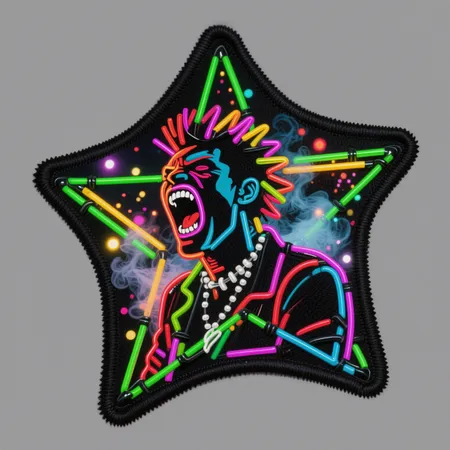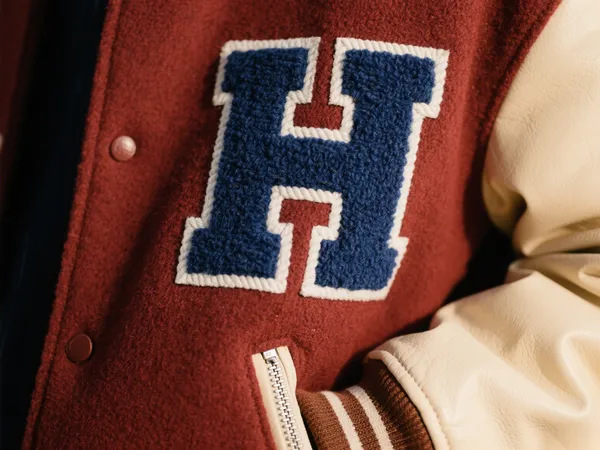Von Lederjacken und Jeanswesten bis hin zu Rucksäcken und Stiefeln, Punk-Patches sind seit langem ein Symbol für Rebellion, Individualität und Nonkonformität. Die aufgenähten oder aufgebügelten Stoffstücke, die in der Punk-Subkultur der 1970er und 80er Jahre entstanden, wurden zu mehr als nur Dekoration – sie wurden zu Statements. Ob sie nun Bands, politische Überzeugungen oder persönliche Kunst promoteten – Punk-Patches haben sich als mutiges Mittel zur Selbstdarstellung bewährt.
In diesem Leitfaden erfahren Sie alles, was Sie wissen müssen über DIY Punk-Patches, einschließlich der Herstellung eigener, der Platzierung und der Authentizität des Looks. Egal, ob Sie neu in der Szene sind oder ein erfahrener Punk-Veteran, dieser Artikel soll Sie inspirieren und informieren.

Was sind Punk-Patches?
Punk-Aufnäher sind Stoffstücke, oft schwarz oder neutral in der Farbe, bedruckt oder bestickt mit Logos, Slogans oder Originalkunstwerken. Meist werden sie auf Kleidung wie Jacken, Hosen und Taschen genäht oder aufgebügelt. Traditionell weisen sie Elemente auf wie:
- Bandnamen (The Sex Pistols, Dead Kennedys, Crass)
- Politische Symbole oder Protestbotschaften
- Künstlerische DIY-Illustrationen
- Totenköpfe, Sicherheitsnadeln und anarchistische Symbole
Was macht benutzerdefinierte Punk-Patches Besonders einzigartig ist, dass sie oft eine persönliche Bedeutung haben. Sie können Ihren Musikgeschmack, Ihre politische Haltung oder sogar Ihre Identität innerhalb der Subkultur widerspiegeln.
Die Bedeutung von DIY in der Punkkultur
Die „Do It Yourself“-Mentalität ist eine der Säulen der Punk-Ideologie. Anstatt Massenware zu kaufen, stellen Punks oft ihre eigene Ausrüstung her. Dazu gehört das Zerreißen alter Kleidung, das Beschriften mit Stoffmarkern und natürlich das Herstellen von DIY Punk-Patches.
Einen eigenen Patch zu kreieren ist nicht nur eine Möglichkeit, Geld zu sparen – es ist ein politischer Akt. Es geht darum, Konsumismus abzulehnen und unverfälschte Emotionen auszudrücken. Selbst ein ungleichmäßiger Stich oder ein schiefer Schnitt erzählen eine Geschichte.

So stellen Sie DIY-Punk-Patches zu Hause her
Du brauchst keine ausgefallene Ausrüstung oder teures Material. Mit ein wenig Kreativität kannst du in wenigen einfachen Schritten auffällige Punk-Aufnäher herstellen.
Benötigte Materialien:
- Schwarzer oder dunkelfarbiger Stoff (alte T-Shirts, Jeans oder Segeltuch eignen sich gut)
- Weiße Stoffmalfarbe oder Bleichstifte
- Schablonen (optional) oder Freihandkunst
- Stoffschere
- Nadel und Faden oder eine Nähmaschine
- Aufbügelkleber (optional)
Steps:
- Schneiden Sie den Stoff zu: Wählen Sie einen Stoff, der nicht so leicht ausfranst. Schneiden Sie ihn auf die gewünschte Größe zu – gängige Flickengrößen sind etwa 7,5 x 10 cm.
- Gestalten Sie Ihre Kunst: Zeichnen Sie entweder direkt mit Stoffmarkern auf den Stoff oder malen Sie mit einer Schablone. Kräftige Weiß-auf-Schwarz-Designs sind am ikonischsten.
- Trocknen und Fixieren: Lassen Sie die Farbe vollständig trocknen. Wenn Sie Farbe verwenden, können Sie diese mit einem Bügeleisen fixieren (siehe Farbanleitung).
- Aufnähen oder Aufbügeln: Für einen authentischen Punk-Look können Sie Ihren Aufnäher von Hand auf Ihre Kleidung nähen. Verwenden Sie große, sichtbare Stiche für einen besonderen Akzent. Für eine bequemere Lösung können Sie auch Bügelkleber verwenden.

Beste Kleidung und Platzierungen für Punk-Patches
Das Schöne an Punk-Patches ist, dass es keine strengen Regeln gibt – nur Tradition und ästhetische Vorlieben. Hier sind einige beliebte Patch-Platzierungen:
- Rückseite einer Jeans- oder Lederjacke (große Statement-Patches)
- Ärmel und Schultern
- Hosentaschen oder Hosenbeine
- Rucksäcke oder Messenger Bags
- Kragen, Revers und sogar Hüte
Das Übereinanderlegen mehrerer Flicken oder deren Überlappung erzeugt einen chaotischen, rebellischen Look, der die Punk-Mode ausmacht. Je „getragener“ Ihr Kleidungsstück aussieht, desto authentischer fühlt es sich an.
Wo Sie benutzerdefinierte Punk-Patches finden oder bestellen können
Wenn das Erstellen eigener Patches nichts für Sie ist, gibt es immer noch Möglichkeiten, das Punk-Ethos zu unterstützen. Viele kleine Unternehmen und Künstler erstellen benutzerdefinierte Punk-Patches die die Underground-Kultur widerspiegeln. Sie können auch mit einem Künstler zusammenarbeiten oder Ihre eigenen Designs über Online-Dienste auf Stoff drucken.
Wenn du in einer Band bist, ist der Druck individueller Patches zum Verteilen bei Konzerten oder als Merchandise eine kostengünstige und wirkungsvolle Möglichkeit, mit deinen Fans in Kontakt zu treten. Du brauchst keine großen Auflagen – limitierte Auflagen machen den Reiz aus.

Pflege und Tipps für Punk-Patches
- Nähen ist stärker als Bügeln: Aufbügelbare Flicken können sich beim wiederholten Waschen lösen, aufgenähte Flicken hingegen bleiben erhalten.
- Kämpfen mit Absicht: Schnittkanten sehen cool aus, aber übermäßiges Ausfransen kann einen Flicken ruinieren. Verwenden Sie Stoffkleber oder einen leichten Stich um die Kante, um das Aussehen zu beeinflussen.
- Vorsichtig waschen: Drehen Sie die Kleidung auf links und verwenden Sie einen Schonwaschgang. Noch besser: Waschen Sie Ihre geflickten Kleidungsstücke mit der Hand.
- Medienmix: Scheuen Sie sich nicht, bemalte, gestickte und bedruckte Patches zu kombinieren. Der Punk-Look lebt von Kontrasten und visuellem Rauschen.
Abschließende Gedanken
Punk-Aufnäher sind mehr als nur Stoff – sie sind Zeichen der Identität. Ob du deine politischen Ansichten lautstark kundtust, deiner Lieblingsband Tribut zollst oder einfach deinen Platz in einer nonkonformistischen Welt beanspruchst – jeder Patch, den du trägst, erzählt eine Geschichte. Eigene Patches zu machen oder sie sorgfältig zu pflegen, ist ein Übergangsritus in die Punk-Mode.
Mit nur wenigen Werkzeugen und viel Einstellung können Sie eine Garderobe aufbauen, die widerspiegelt, wer Sie sind – Stich für Stich.
Also los, schnapp dir deine alte Jeans oder die Secondhand-Jacke und mach sie zu deiner. Im Punk ist Perfektion langweilig. Authentizität ist alles.



